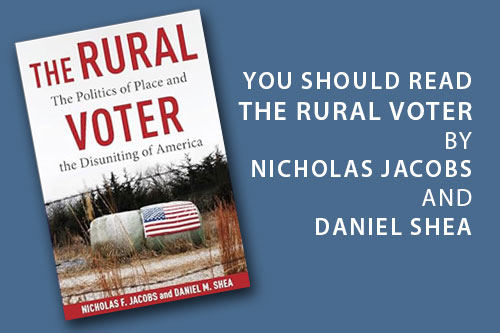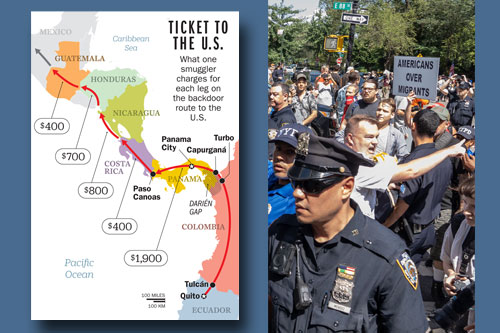In their Rockridge Institute multi-part post “The Logic of the Health Care Debate,” George Lakoff, Eric Haas, Glenn W. Smith and Scott Parkinson dissect the rationales, assumptions and arguments behind the debate over health care reform. It’s very much a Lakoffian exercise, contrasting the psycholinguistics behind “progressive, conservative, and neoliberal” verbiage on health care. Democratic campaigns should find the insights helpful in addressing Republican spin on one of the top-ranking concerns of voters. For example, from the section on “The Conservative Mode of Thought”
In the conservative mode of thought, securing health insurance is a matter of individual responsibility. In this view, health care is a commodity that should be bought and sold through insurance policies in the market. If someone wants a commodity, they should work hard to afford it. In a free market economy — given that America is a land of opportunity — they will be able to do so. Anyone without health insurance for himself or his family just isn’t working hard enough and doesn’t deserve it. It’s just like plasma TVs; if you want one, work hard to afford one. Otherwise, you won’t get it, because you haven’t worked hard enough, and you don’t deserve it.
From the principle of individual responsibility, it follows that employers should never be forced to provide health insurance for their employees. They might choose freely to do so in order to attract talent, but that should be their free choice.
Within the conservative mode of thought, the market is both natural and moral. Natural in that people instinctively seek their own profit and moral in that those who are most disciplined will be most likely to prosper. Market outcomes are therefore always moral and most practical, since the market optimizes the fair and efficient distribution of goods and services. Government interference compromises both the efficiency and morality of market processes.
In conservative thought, health insurance should be a money-making business; it will be most fair and efficient that way. Conservative thought also supports private medical accounts on two similar grounds. First, they are moral because they make the individual responsible. Second, they are practical in that the money can be invested in the market, thereby creating more profits for more people.
What about the denial of care or coverage? In conservative thought this is inevitable and necessary. Your lack of coverage is your own fault. You have not been self-disciplined. You have failed in your individual responsibility to earn it. It’s not the fault of the market or insurance companies. Insurance companies provide a service at a profit, and when they cannot provide that service at a profit, they should not do so. Moreover, those who are uncovered have an incentive to work harder and earn coverage. People do not have the moral right to have someone else pay for their health care coverage; indeed it would be immoral to do so, since that promotes dependency.
Promoting dependency — whether by patients, doctors, or plan administrators — is the root of the conservative fear of health care for all Americans. Conservatives label this as “socialized medicine” or “government health care,” and they argue that health care for all Americans will undermine our self-discipline and make us weak. This is, above all, a moral issue for conservatives, which is why economic efficiency arguments alone will not carry the day with them. For example, we already know that U.S. Medicare and Canada’s single-payer health care system are more efficiently managed than U.S. private, profit-maximizing insurance companies.3 There is also compelling evidence that savings on the profit and administrative costs of the current private insurance companies could pay for health care for all Americans, if it were run as a single payer system.4 From the conservative perspective, these plans are still viewed from top to bottom as unearned entitlements — automatic care for patients, guaranteed income for doctors, and lifetime jobs for government administrators — and so promote dependency and are immoral.
Finally, once health care is understood as a commodity, then the logic of the market sets the value of human life and limb. Therefore, there should be a limit — a cap — on the value that can be claimed in a lawsuit when medical error causes disability or death.
This conservative logic fits perfectly the practice of health insurance companies and makes sense of the following quotes from conservative leaders.
The authors then quote Nixon, Guiliani, Romney and the National Review to prove their point. In their equally-eloquent section on “The Neoliberal Mode of Thought,” they discuss the “Surrender-in-Advance Trap” that they feel some Democrats have blundered into, noting:
With an exaggerated emphasis on system-based solutions, neoliberal thought may lead one to surrender in advance the moral view that drives an initiative in the first place. Those who pragmatically focus on appeasing what they assume will be unavoidable political opposition to their proposals also run the risk of moral surrender…They deeply believe that progressive moral principles can be served through neoliberal methods and forms of argument. We want to stress, however, that the consequence is dire whatever the motivation. The failure to articulate a clear progressive morality in favor of more technocratic solutions to profit-maximizing markets puts the progressive cause at a disadvantage on health care and other policy issues as well. It doesn’t matter whether one is simply trying to avoid conservative and insurance company opposition or whether one truly believes in one’s heart that the market will cure us. The progressive moral basis for providing health care for all — empathy and responsibility, protection and empowerment — is not stated. As a result, Americans don’t get to hear the progressive moral basis for extending health care to all Americans, and they don’t get to decide whether they agree with that moral premise. Americans only hear the conservative moral view. That moves them in a conservative direction, not only on this issue, but on all issues.
Lakoff et al see the neoliberal approach as a poor substitute for comprehensive reform, and one which has deadly consequences:
System tinkering — eliminating pre-existing condition exclusions, adding mandatory coverage for this or that ailment, subsidizing (substandard) health care for the poor — will make a difference for many, but not for all. It will leave many more people with the kind of dissatisfaction that those with present health insurance have rightly been complaining about. Tinkering like that is more concerned with saving a system that has already failed than it is with the health of a society, indeed, with saving lives.
The authors’ argument is moral at the root, but they do offer an important strategic consideration:
The best way to proceed is to keep what we care the most about at the center of the discussion of health care security. What we care the most about is the actual health and well-being of flesh-and-blood people. Keeping this care in our hearts does not mean that temporary compromises will not be necessary. It means only that we don’t begin with compromise.
Lakoff and his co-authors have made a compelling argument for a bold strategy for comprehensive health care reform, and they have a lot more to say about the terms of the debate than can be recounted here. Democratic candidates would do well to give due consideration to their challenge on the road to November ’08.









